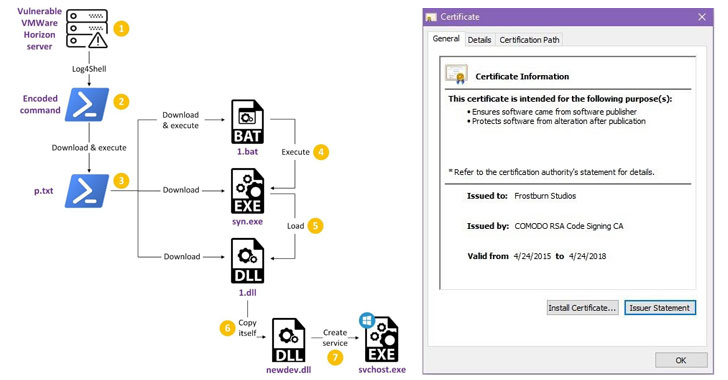A Chinese advanced persistent threat tracked as Deep Panda has
been observed exploiting the Log4Shell vulnerability[1]
in VMware Horizon servers to deploy a backdoor and a novel rootkit
on infected machines with the goal of stealing sensitive data.
“The nature of targeting was opportunistic insofar that multiple
infections in several countries and various sectors occurred on the
same dates,” said[2]
Rotem Sde-Or and Eliran Voronovitch, researchers with Fortinet’s
FortiGuard Labs, in a report released this week. “The victims
belong to the financial, academic, cosmetics, and travel
industries.”
Deep Panda[3], also known by the
monikers Shell Crew, KungFu Kittens, and Bronze Firestone, is said
to have been active since at least 2010, with recent attacks
“targeting legal firms for data exfiltration and technology
providers for command-and-control infrastructure building,”
according[4]
to Secureworks.
Cybersecurity firm CrowdStrike, which assigned the panda-themed
name to the group all the way back in July 2014, called[5]
it “one of the most advanced Chinese nation-state cyber intrusion
groups.”
The latest set of attacks documented by Fortinet shows that the
infection procedure involved the exploitation of the Log4j remote
code execution flaw (aka Log4Shell) in vulnerable VMware Horizon
servers to spawn a chain of intermediate stages, ultimately leading
to the deployment of a backdoor dubbed Milestone (“1.dll”).
Based on the leaked source code of the infamous Gh0st RAT[6]
but with notable differences in the command-and-control (C2)
communication mechanism employed, Milestone is also designed to
send information about the current sessions on the system to the
remote server.
Also detected during the attacks is a kernel rootkit called
“Fire Chili” that’s digitally signed with stolen certificates from
game development companies, enabling it to evade detection by
security software and conceal malicious file operations, processes,
registry key additions, and network connections.
This is achieved by means of ioctl[7] (input/output control)
system calls to hide the driver rootkit’s registry key, the
Milestone backdoor files, and the loader file and process used to
launch the implant.
Fortinet’s attribution to Deep Panda stems from overlaps between
Milestone and Infoadmin RAT, a remote access trojan used by the
sophisticated hacking collective in the early 2010s, with
additional clues pointing to tactical similarities to that of the
Winnti group.
This is backed by the use of compromised digital signatures
belonging to gaming companies, a target of choice for Winnti, as
well as a C2 domain (gnisoft[.]com), which has been previously linked[8]
to the Chinese state-sponsored actor in 2020.
“The reason these tools are linked to two different groups is
unclear at this time,” the researchers said. “It’s possible that
the groups’ developers shared resources, such as stolen
certificates and C2 infrastructure, with each other. This may
explain why the samples were only signed several hours after being
compiled.”
The disclosure adds to a long list of hacking groups[9] that have exploited the
Log4Shell vulnerability targeting VMware’s virtualization
platform.
In December 2021, CrowdStrike described an unsuccessful campaign
undertaken by an adversary dubbed Aquatic Panda[10] that leveraged the flaw
to perform various post-exploitation operations, including
reconnaissance and credential harvesting on targeted systems.
Since then, multiple groups have joined the fray, including the
Iranian TunnelVision group[11], which was observed
actively exploiting the Log4j logging library defect to compromise
unpatched VMware Horizon servers with ransomware.
Most recently, cybersecurity company Sophos highlighted[12] a slew of attacks
against vulnerable Horizon servers that have been ongoing since
January and have been mounted by threat actors to illicitly mine
cryptocurrency, install PowerShell-based reverse shells, or to
deploy Atera agents to remotely deliver additional payloads.
“Attempts to compromise Horizon servers are among the more
targeted exploits of Log4Shell vulnerabilities because of their
nature,” Sophos researchers said, adding “platforms such as Horizon
are particularly attractive targets to all types of malicious
actors because they are widespread and can (if still vulnerable)
easily found and exploited with well-tested tools.”
References
- ^
Log4Shell vulnerability
(thehackernews.com) - ^
said
(www.fortinet.com) - ^
Deep
Panda (attack.mitre.org) - ^
according
(www.secureworks.com) - ^
called
(www.crowdstrike.com) - ^
Gh0st
RAT (malpedia.caad.fkie.fraunhofer.de) - ^
ioctl
(en.wikipedia.org) - ^
previously linked
(www.welivesecurity.com) - ^
long
list of hacking groups (thehackernews.com) - ^
Aquatic Panda
(thehackernews.com) - ^
TunnelVision group
(thehackernews.com) - ^
highlighted
(news.sophos.com)
Read more https://thehackernews.com/2022/04/chinese-hackers-target-vmware-horizon.html

